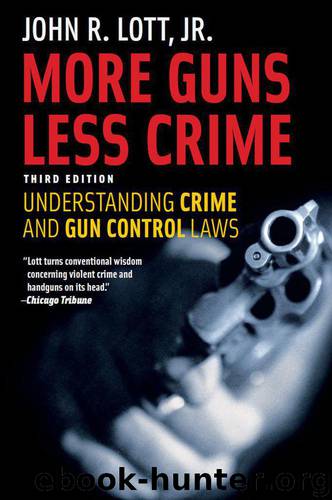More Guns, Less Crime: Understanding Crime and Gun Control Laws, Third Edition by John R. Lott Jr

Author:John R. Lott Jr. [Lott, John R. Jr.]
Language: eng
Format: epub, mobi
ISBN: 9780226493664
Publisher: University Of Chicago Press
Published: 2013-07-16T03:00:00+00:00
Table 10.3 Criteria for permits based on when the right-to-carry laws went into effect
Note: Values are for 2005.
aExcluding Vermont, which had no permits.
bExcluding Vermont, which had no age requirements.
These restrictions appear to have a large effect on permit-issuing rates. In 2008, applications for permits in Georgia soared by 79 percent, a much larger increase than seen in other states after Obama’s election.93 One of the most prominent reasons given for the increase was “a law change last year that opened up the places where a concealed weapon is allowed.”
The fees, training requirements, permit duration, and number of prohibited places all have important implications for studying right-to-carry laws. If criminals are indeed discouraged by a higher probability of a potential victim being able to defend herself, then states that only recently adopted right-to-carry laws should have fewer permit holders and a smaller reduction in crime rates.
A problem of growing inconvenience for future research involves the increasing issuance of nonresidential permits. Two states in particular (Florida and Utah) are giving out a large number of permits to out-of-state residents. Utah’s permits for out-of-state residents are honored in twenty-eight states, while Florida’s are honored in twenty-seven states. The changes have been particularly significant during the last few years, and over 100,000 permits in these two states are now held by out-of-state residents.94 Over time, permits issued by Florida and Utah will have a great impact on researchers knowing how may people in other states possess concealed-handgun permits.
The Results
My primary approach here is to let the estimated changes in crime rates “take their own shape” rather than assume that they fit a straight line or some other particular shape.
As a first pass, the regressions account for all the possible influences and consider the year-by-year effects by two-year intervals, from nine years before the right-to-carry law is passed until fourteen years after the law.95 Two other variables measure the crime rates ten or more years before the law goes into effect and fifteen or more years afterward. Thus, rather than a before-and-after trend and possibly also a variable to measure any changes in the before-and-after averages, this approach has fourteen variables to measure more precisely how crime rates are changing before and after right-to-carry laws are adopted. Only for 2.6 percent of the sample do states that have adopted a right-to-carry law have their laws in effect for at least fifteen or more complete years. Any changes in crime rates for these right-to-carry states are relative to the changes in crime rates for the states without these laws.
Figures 10.1a–10.1i show some dramatic results. There are large drops in overall violent crime, murder, rape, and aggravated assault that begin right after the right-to-carry laws have gone into effect. In all those crime categories, the crime rates consistently stay much lower than they were before the law.
The murder rate for these right-to-carry states fell consistently every year relative to non-right-to-carry states. When the laws were passed, the average murder rate in right-to-carry states was 6.3 per 100,000 people.
Download
More Guns, Less Crime: Understanding Crime and Gun Control Laws, Third Edition by John R. Lott Jr.mobi
This site does not store any files on its server. We only index and link to content provided by other sites. Please contact the content providers to delete copyright contents if any and email us, we'll remove relevant links or contents immediately.
| Anthropology | Archaeology |
| Philosophy | Politics & Government |
| Social Sciences | Sociology |
| Women's Studies |
The Secret History by Donna Tartt(18805)
The Social Justice Warrior Handbook by Lisa De Pasquale(12126)
Thirteen Reasons Why by Jay Asher(8767)
This Is How You Lose Her by Junot Diaz(6760)
Weapons of Math Destruction by Cathy O'Neil(6116)
Zero to One by Peter Thiel(5661)
Beartown by Fredrik Backman(5575)
The Myth of the Strong Leader by Archie Brown(5401)
The Fire Next Time by James Baldwin(5224)
How Democracies Die by Steven Levitsky & Daniel Ziblatt(5111)
Promise Me, Dad by Joe Biden(5077)
Stone's Rules by Roger Stone(5013)
100 Deadly Skills by Clint Emerson(4824)
A Higher Loyalty: Truth, Lies, and Leadership by James Comey(4822)
Rise and Kill First by Ronen Bergman(4682)
Secrecy World by Jake Bernstein(4618)
The David Icke Guide to the Global Conspiracy (and how to end it) by David Icke(4606)
The Farm by Tom Rob Smith(4421)
The Doomsday Machine by Daniel Ellsberg(4397)
